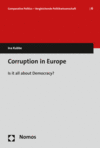Corruption in Europe
Is it all about Democracy?
Abstract
Auch wenn europäische Staaten vergleichsweise geringe Korruptionswerte aufzeigen, verdeutlichen Skandale immer wieder, dass Korruption ein großes Problem darstellt, mit dem auch Europa stark zu kämpfen hat. Die Autorin untersucht daher die Ursachen von Korruption auf dem europäischen Kontinent. Verschiedene Analysen zeigen, dass Kontextfaktoren eines Landes wie dessen ökonomischer Entwicklungsstand, der Demokratisierungsgrad und die jeweilige Dauer oder historische Faktoren wie die kommunistische Vergangenheit das Auftreten von Korruption stark beeinflussen.
Darüber hinaus spielen interpersonales Vertrauen und die Rechtfertigung von Bestechungszahlungen eine erhebliche Rolle in der Wahrnehmung von Korruption. Insgesamt zeigen die Befunde, dass letztendlich eine „demokratische Kultur“ der Schlüssel im Kampf gegen Korruption in Europa ist. Diese fördert demokratische Institutionen sowie Normen und Werte, die darauf abzielen, korrupte Akteure zu kontrollieren und sanktionieren.
Zusammenfassung
Auch wenn europäische Staaten vergleichsweise geringe Korruptionswerte aufzeigen, verdeutlichen Skandale immer wieder, dass Korruption ein großes Problem darstellt, mit dem auch Europa stark zu kämpfen hat. Die Autorin untersucht daher die Ursachen von Korruption auf dem europäischen Kontinent. Verschiedene Analysen zeigen, dass Kontextfaktoren eines Landes wie dessen ökonomischer Entwicklungsstand, der Demokratisierungsgrad und die jeweilige Dauer oder historische Faktoren wie die kommunistische Vergangenheit das Auftreten von Korruption stark beeinflussen.
Darüber hinaus spielen interpersonales Vertrauen und die Rechtfertigung von Bestechungszahlungen eine erhebliche Rolle in der Wahrnehmung von Korruption. Insgesamt zeigen die Befunde, dass letztendlich eine „demokratische Kultur“ der Schlüssel im Kampf gegen Korruption in Europa ist. Diese fördert demokratische Institutionen sowie Normen und Werte, die darauf abzielen, korrupte Akteure zu kontrollieren und sanktionieren.
- 1–18 Titelei/Inhaltsverzeichnis 1–18
- 19–20 List of Abbreviations 19–20
- 21–52 1 Thinking about Corruption in Europe 21–52
- 1.1 Relevance of the Study
- Structure of the Study
- 1.2 Definition and Characteristics of Corruption
- 1.2.1 Definition of Corruption
- Market-Centered Definitions
- Public-Interested-Centered Definitions
- Public-Office-Centered Definitions
- 1.2.2 Characteristics of Corruption
- Public versus Private Corruption
- Petty versus Grand Corruption
- Passive versus Active Corruption
- 1.3 Theoretical Approaches on the Causes of Corruption
- 1.3.1 Economic Perspectives: The Role of Rational Interests on Corruption
- 1.3.2 Sociological Perspectives: The Role of Culture on Corruption
- 1.3.3 Evaluation of Theoretical Corruption Research
- 1.4 Empirical Studies of the Causes of Corruption
- 1.4.1 Evaluation of Empirical Corruption Research
- 53–98 2 Bathtub Model of Corruption 53–98
- 2.1 Panel and Multilevel Analysis: A New Framework
- Bathtub Model of Corruption
- 2.2 Corruption in European Countries
- 2.3 Measuring Corruption: The Dependent Variable Reconsidered
- 2.3.1 The Aggregate Level: Macro Level Indices
- Control of Corruption Index
- Corruption Perceptions Index
- International Country Risk Guide
- 2.3.2 Critical Evaluation of Using Macro Corruption-Indices
- 2.3.3 The Individual Level: Micro Level Indices
- 2.3.4 Critical Evaluation of Using Micro Corruption-Indices
- 2.4 Variables and Research Hypotheses: Aggregate and Individual Levels Combined
- 2.4.1 The Macro Level: Economic, Political, Socio-Cultural and Historical Factors
- 2.4.1.1 Economic Factors
- Economic Development
- EU-Membership
- Further Economic Factors
- 2.4.1.2 Political Factors
- Degree of Democracy
- Women in Parliaments
- Further Political Factors
- 2.4.1.3 Socio-Cultural Factors
- Religion
- Further Socio-Cultural Factors
- 2.4.1.4 Historical Factors
- Years of Democracy
- Communist Past
- Further Historical Factors
- 2.4.2 The Micro Level: Socio-demographic Characteristics, Values, Norms and Attitudes
- 2.4.2.1 Socio-Demographic Characteristics
- Gender
- Age
- Employment Status
- Level of Income
- 2.4.2.2 Values and Norms
- Level of Interpersonal Trust
- 2.4.2.3 Attitudes
- Satisfaction with Financial Situation
- Justification of Bribery
- Further Socio-demographic Characteristics, Values, Norms and Attitudes
- 99–159 3 Unpacking Corruption in Europe 99–159
- 3.1 Explaining Corruption at the Macro Level
- 3.1.1 Measuring Corruption at the Country Level
- 3.1.2 Empirical Findings: The Impact of Country Characteristics on Corruption
- 3.1.2.1 Economic Factors
- Economic Development
- EU-Membership
- 3.1.2.2 Political Factors
- Degree of Democracy
- Women in Parliaments
- 3.1.2.3 Socio-Cultural Factors
- Religion
- Percentage of Catholics
- Percentage of Orthodox
- Percentage of Protestants
- Percentage of Muslims
- 3.1.2.4 Historical Factors
- Years of Democracy
- Communist Past
- 3.2 The Impact of Country Characteristics on Corruption
- Robustness Check
- 3.3 Explaining Corruption at the Micro Level
- 3.3.1 Measuring Corruption at the Individual Level
- 3.3.2 Empirical Findings: The Impact of Socio-Demographic Characteristics, Values, Norms, and Attitudes on Corruption
- 3.3.2.1 Socio-Demographic Characteristics
- Gender
- Age
- Employment Status
- Level of Income
- 3.3.2.2 Values and Norms
- Level of Interpersonal Trust
- 3.3.2.3 Attitudes
- Satisfaction with Financial Situation
- Justification of Bribery
- 3.4 The Impact of Individual Characteristics on Corruption
- 160–184 4 The Bigger Picture of Corruption in Europe 160–184
- 4.1 Macro Model of Corruption in Europe
- Macro Model of Corruption
- 4.2 Micro Models of Corruption in Europe
- 4.3 Europe’s Bathtub Model of Corruption
- European-Specific Bathtub Model
- 4.4 Conclusion and Research Prospects
- Limitations and Implications for Future Research
- 185–206 5 References 185–206
- 207–218 Appendix 207–218
- Appendix A: Literature Overview
- Appendix B: Independent Variables
- 219–220 Active corruption 219–220


